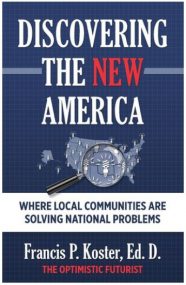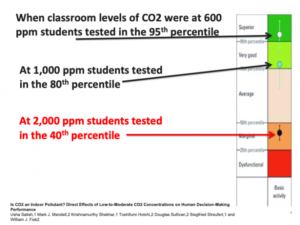Welcome to America's Optimistic futurist
Proven ways to improve kids' learning
without messing with teachers.

Need a Partner? Try the U.S. Department of Energy's Teaming Partner List.
Energy costs too high at your school? Learn about DOE's Qualified List of Energy Service Co's.
NEW Subscriber?
Find Past Newsletters of interest, below!
Newsletter of the Week
Boston Schools Are Posting All Classroom Air Quality Online!
Let's start with a question about memory: When tested a month after learning new information, how much do most people remember? Research shows only about 20-30% sticks. This is why effective teachers constantly review and reinforce key concepts—it's essential for learning and for better test scores.
So let me reinforce something important you may have read here before, then share some exciting news from Boston.
The Air Quality Challenge
North Carolina spends $12,492 per K-12 student annually (combining federal, state, and local funding). That puts us in the bottom two or three states nationally—well below the national average of $17,074 per student. Given these limited resources, we need to ensure every dollar delivers maximum learning impact.
Here's what undermines that investment: Every time you breathe out, our exhaled air contains 100 times more carbon dioxide (CO2) than the air you inhaled. In poorly ventilated classrooms, CO2 rises with each breath out. As CO2 levels climb above 600 parts per million, cognitive function measurably declines—for both students and teachers. The higher the CO2, the greater the impact on concentration, memory, and learning.
Boston's Groundbreaking Solution
Here's the exciting news: Using grant money, Boston University professors Patricia Fabian and Lucy Hutyra have compiled data from approximately 5,000 sensors installed throughout Boston's school system—and they've made their findings completely public!
Citizens in Boston can now see the air pollution levels of every classroom in their school system simply by going online. Visit the dashboard at Boston Public Schools Indoor Air Quality.
What We're Finding in North Carolina
Our organization has provided free air quality monitoring equipment to educators across North Carolina, surveying more than 850 classrooms. The results are consistent: approximately half of these classrooms have air quality poor enough to lower student performance by one to two letter grades. Think about what that means. We're already investing less per student than most states.
On top of that, when poor air quality undermines learning in half our classrooms, we're wasting precious education dollars on an easily addressable problem.
The Power of Transparency
What will happen in Boston now that air quality data is public? When parents can see their child's classroom showing high pollution levels, they'll demand action. When school boards see the data mapped across their districts, priorities will shift. Transparency creates accountability, and accountability drives improvement—all good for kids.
Simple Steps You Can Take Now
We don't have to wait for comprehensive system overhauls. There are practical steps schools can implement immediately. Here are just a few:
- Ensure school buses aren't idling near fresh air intakes
- Open classroom windows 4 inches to dilute CO2 levels
- In older buildings, open transom windows above classroom doors to allow healthier hallway air to circulate
There are many other steps we can introduce you to improve this situation. Some of the most impactful, and with the highest rate of return, will involve action by the state legislature, or in the case of the Leandro lawsuit (which is in its third decade of debating if all students in North Carolina should get equal financial support), the courts.
You can also start testing these opportunities at home. Our organization loans free monitoring equipment so you can measure air quality in your home or workplace. Some devices connect to smartphone apps, letting you monitor conditions remotely - helpful when your kids are home alone.
Moving Forward Together
Boston has shown us that it's possible to share information about classroom environments. Our question now is whether North Carolina school systems will follow their lead. This first step would demonstrate that our state cares about giving students the healthy learning environments they deserve—environments where every education dollar invested in our children can achieve its full impact.
In upcoming newsletters, we'll be reporting on North Carolina schools that are beginning to gather data on learning environments. If you know of efforts we should celebrate, please contact us.
To borrow free air quality monitoring equipment, visit The Lending Library, or tell us what you need by completing a Request to Borrow Tools.
An Expert Endorsement
Indoor air systems crucial to curbing spread of viruses, aerosol researchers say | 60 Minutes
Joseph G. Allen, Professor of Exposure Assessment Science
Harvard T.H. Chan School of Public Health
How You and Your Community Can Benefit from
the "Required Minimum Distribution"
If you or your parents have passed the milestone of age 73 and maintain a retirement account, you are probably aware of the mixed blessing known as the Required Minimum Distribution. At age 73, and every year thereafter, you are required to take a compulsory withdrawal of funds from your (until now) tax free retirement account. The amount increases your federal taxes owed for that year.
There is, however, a neat opportunity to avoid paying those taxes and do good at the same time: you can make what the Internal Revenue Service calls a "Qualified Charitable Distribution."
If you own a traditional, SEP, or SIMPLE IRAs, or 401(k, 403(b), 457(b), profit-sharing, or other defined contribution plan, you can instruct your account Trustee to donate directly to a specific charity, such as including a public school. When you do so, these dollars are excluded from taxable income on your tax return.
Our partner organization, The Pollution Detectives, Inc., is a nonprofit, 501(c)3 organization that meets the criteria for a qualified charity under this rule. Its mission—to make the invisible visible—emphasizes the impact on childhood learning of environmental conditions that cannot be readily perceived by human senses. For no charge, TPD lends special detection tools to students, teachers, school systems, community organizations, and residents to survey the indoors for air pollutants, mold, and radon. To those who borrow these devices, TPD provides reports, interpretive guidance, and advice about ways to lower the presence of undesirable substances after they are identified.
The Pollution Detectives, Inc.’s work at more than 850 locations has enabled schools throughout North Carolina to provide a better learning environment for students.
If you value The Pollution Detectives, Inc.’s work in the community, please ask your Trustee to make a Qualified Charitable Distribution to:
Nova Credit Union Routing Number 253075031
Savings Account Number 1000001384502
My books containing other success stories

Written in 2015, this was my first attempt at celebrating successful actions taken by K-12 schools. Although the data is now outdated, the 22 concepts in this book are still valid, and worth a read. The website above will continue to add to that library - look on the right side for more recent role model stories.

We are living in an era when many Americans feel things are out of their control, which causes them frustration, anger, and depression. This book explains the theory and practice of how to influence the direction and growth of your local economy, and regain your power to protect your community and family. First published in 2016, the lessons remain accurate and powerful.

As a country, we are not without solutions. This collection, first published in 2013, takes a country-wide locally solvable view of significant issues which still exist, and in may ways have gotten worse since I first wrote about them. You, can solve these problems by imitating the behavior of the pioneer efforts cited here.
Don’t miss out on new content
Stay up to date with the latest articles, news, or books.
Francis P. Koster Ed.D.
Proven local solutions to national problems.
CONTACT
Copyright © 2023 America's Optimistic Futurist
